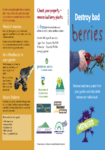-
Hydrology and Meteorology of the Paekakariki Storm 3 October 2003
This report summarises the meteorology and hydrology of the
3 - 4 October 2003 storm event in the Wellington region. The
report gives an overview of the synoptic weather patterns,…alarm Published 01 Nov 2003 -
Greater Wellington Regional Pest Management Strategy 2002-2022 Operational Report 2002-2003
This document reports on the performance of the 2002-2003
Operational Plan for the Greater Wellington Regional Pest
Management Strategy (RPMS), as required by the Regional
Council under Section 85 of…alarm Published 01 Nov 2003 -
Transport Futures - November 2003
This summary is produced by the RLTC Chairperson to provide
members, mayors, officers and others interested with a quick
summary of recent Regional Land Transport Committee
proceedings. It is a…alarm Published 01 Nov 2003 -
Greater Wellington Water - Report of Business Activity 2002/2003
This report covers the main achievements and challenges for
Greater Wellington Regional Council's Water business (GW
Water), arising during the 2002/03 financial year.
The Council's statutory reporting requirements are fulfilled by…alarm Published 01 Nov 2003 -
Hydraulic Modelling of Lower Ruamahanga River
Purpose of the Report:
To assess flood capacity and optimise flood protection in the Lower Ruamahanga River system.
Geographic Area Covered:
The report covers the Lower Ruamahanga River and surrounding floodways, including Lakes…alarm Published 01 Nov 2003 -
Transport Futures : An occasional newsletter from Greater Wellington Transport
This edition includes:
Land Transport Management Bill reported back
RLTS review developments
New policy areas for the next RLTS vulnerability, freight
Regional Transport Programme: transport funding gap
Corridor plansalarm Published 31 Oct 2003 -
Greater Wellington Regional Pest Management Strategy 2002-2022 Pest Plants and Pest Animals Operational Plan 2003-2004
This document reports on the performance of the Operational Plan
2003-2004 for the Greater Wellington Regional Pest Management
Strategy (RPMS) as required by the Regional Council under
Section 85 of…alarm Published 01 Oct 2003 -
Storing Emergency Water
This fact sheet explains why storing water is one of the
most important actions you can do to be prepared for an
emergency.
Storing Emergency Water includes:
Why store water?
How…alarm Published 01 Oct 2003 -
Greater Wellington Regional Pest Management Strategy 2002-2022 Pest Plants and Pest Animals Operational Plan 2003-2004
This document reports on the performance of the Operational Plan
2003-2004 for the Greater Wellington Regional Pest Management
Strategy (RPMS) as required by the Regional Council under
Section 85 of the…alarm Published 01 Oct 2003 -
Destroy Bad Berries - Remove bad berry plants from your garden and help birds restore our native bush
Check your property - Remove bad berry plants
Weeds damage native forest by spreading, smothering and
squeezing out native plants. Remove bad berry plants from
your garden and…alarm Published 01 Oct 2003

